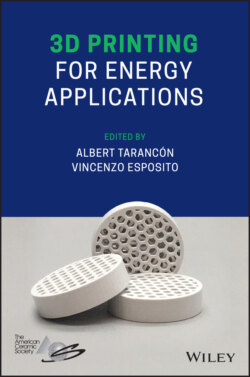Читать книгу 3D Printing for Energy Applications - Группа авторов - Страница 14
I.3 3D Printing for Energy
ОглавлениеThe possibility of printing functional materials with applications in energy has been attracting a growing attention since 3D printing technologies represent a new paradigm for the manufacture of energy conversion and storage technologies [13]. Among other advantages, additive manufacturing offers unique capabilities for increasing the specific performance per unit mass and volume of energy devices by implementing high levels of hierarchical and shape complexity. While the implementation of multiscale features can be of great interest for chemical reactors or batteries, a high level of shape flexibility becomes crucial in harvesting applications where the efficiency of the generators strongly depends on their capability to properly couple to variable scenarios, for example, for a good adaptability of thermoelectric generators to the source of waste heat. Complementary, the opportunity to implement fully controlled graded compositions or tuneable porosity, that is, a certain level of materials complexity, also represents a big advantage for those energy devices with multiple interfaces or porous electrodes, such are fuel cells, gas separation membranes, or electrochemical capacitors. Despite this potential, the fabrication of highly complex devices for the energy sector by using 3D printing is just an emerging field [17]. This is probably due to the complexity of the devices usually employed. However, since the complexity adds cost to traditional processes, the more complex the final part, the more likely that AM will be of benefit for the sector [16].
This emerging application of 3D printing already end up with remarkable examples of the fabrication of components for solid oxide fuel cells [14, 24, 25], batteries [15, 26], or photovoltaic systems [27, 28]. Despite most of the existing examples in energy applications correspond to low‐aspect ratio deposition of functional layers (mainly by inkjet), increasing activity is devoted to proper 3D printing of complex shape multi‐material parts and devices. In this direction, the most inspiring examples were reported by Kim et al. [21] and Pesce et al. [29] who were able to fabricate high‐aspect ratio interdigitated Li‐ion microbatteries by inkjet printing of concentrated viscoelastic inks of complex lithium oxides and solid oxide cells based on corrugated oxide‐ion YSZ electrolytes by SLA, respectively. More activity in complex shapes has been recorded in the field of heterogeneous catalysis or solar systems. Different authors have reported 3D fabrication of catalyst supports based on alumina [] and plastic‐made light concentrators [23]. Although in these cases the 3D printing techniques were employed to fabricate the structural but functional parts of the systems, they proved the interest of 3D printing for resolving problems related to limitations in the classical fabrication of relevant parts. Regarding chemical engineering, internally structured reactors available by 3D printing can play a very important role allowing solutions that were not reachable previously [33]. The main goal is a balanced integration of mass, heat, and momentum transfer in the 3D printed reactor [34] by generating an internal structure by design rather than chance, like in packed bed, monolithic‐ or foam‐type reactors. In the case of solar concentration, 3D‐printed traps made of smoothened silver‐coated thermoplastic resulted in a relevant improvement of the external quantum efficiency of crystalline silicon, thin film nanocrystalline silicon and organic solar cells [23].
With the expected increase of such successful experiences in printing relevant parts for the energy industry, it will progressively start adopting 3D printed devices and systems. The energy manufacturing sector is expected to be more reluctant to adopt the printing technology than end‐users to integrate printed objects (if their performance is kept similar or is improved). On the other hand, more inconveniences are foreseen for end‐users regarding required standards and certifications of their products. These standardization efforts should go together with quantitative Life Cycle Assessment studies on the reduction of waste material and energy consumption as well as the evaluation of the recyclability and ecological impacts of these alternative products. Moreover, a full deployment of the 3D printing technologies for a huge market as the energy requires an industry laying on a robust value chain. Currently, there is an absence of redundant big players in almost all the steps of this value chain and a lack of skilled workforce (from designers to operators), more noticeably for functional materials such as ceramics.
Another important point to cover to reach the energy market, is the development of big size and high speed 3D printing processes able to cover a high and increasing demand. This evolution from a prototyping to a manufacturing approach will be driven by increasing the complexity of the printed parts (extending capabilities to fabricate high value‐added parts such are devices) and ultimately pointing the upcoming mass customization of energy products. Mass customization refers the fabrication of custom‐made products at a competitive price. In this regard, developing “tabletop factories” such as 3D printers will generate a competitive manufacturing process in terms of product flexibility and short time‐to‐market for energy devices boosting the idea of an industry 4.0 based on mass customization by 3D printing.
